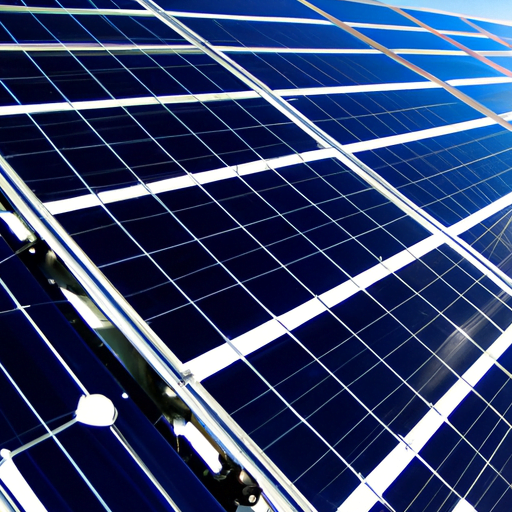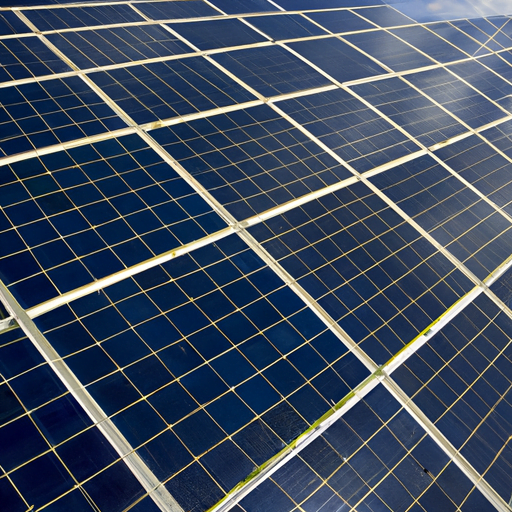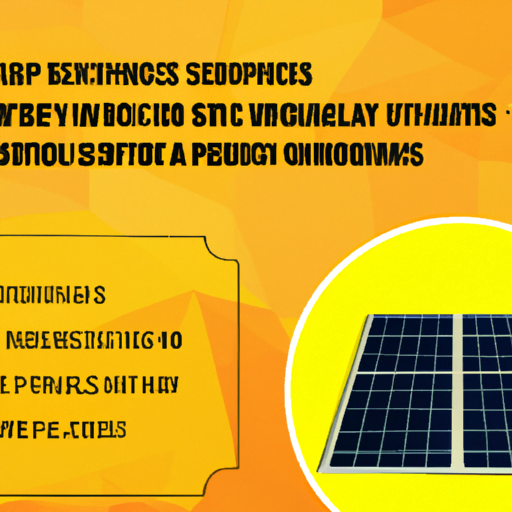So, you’ve decided to live off the grid and harness the power of the sun to meet your daily energy needs. That’s fantastic! Going solar is not only environmentally friendly, but it can also save you a substantial amount of money in the long run. One of the key questions you may be wondering is how many solar panels you’ll need to generate 10 kWh of energy every day. Well, fear not, because we’re here to shed some light on the matter!
To determine the number of solar panels required for 10 kWh of daily energy consumption, several factors need to be taken into consideration. Firstly, you’ll need to determine the average sunlight hours in your location. Keep in mind that this can vary throughout the year. Geographic location, weather patterns, and shading from surrounding objects can all impact the available sunlight.
Additionally, the efficiency and wattage of the solar panels you choose will play a role in the calculation. Solar panels have different efficiencies, which means some may generate more electricity from the same amount of sunlight compared to others. The wattage of the panels will also determine how much electricity they can produce.
Don’t worry if all this seems overwhelming; we’ll be diving deep into the details in our full article. We’ll walk you through step-by-step on how to determine the number of solar panels required for your specific energy needs. Stay tuned to learn more about harnessing the power of the sun and becoming your own sustainable energy powerhouse!
Understanding Daily Energy Consumption
Daily energy consumption refers to the amount of energy used by a household or an individual on a daily basis. It is an important factor to consider when determining the size of solar panels needed for a property. By understanding daily energy consumption, one can accurately calculate the total wattage required and ensure that the solar panels can meet the energy needs efficiently.
Calculating Daily Energy Consumption
To determine daily energy consumption, you need to consider the energy usage of various appliances and electronics in your home. This can be done by checking the wattage of each device and multiplying it by the number of hours it is used per day. The sum of these individual calculations will give you the total daily energy consumption in watt-hours (Wh).
For example, if you have a refrigerator that consumes 200 watts and is used for 24 hours, the calculation would be:
200 watts x 24 hours = 4800 watt-hours (or 4.8 kWh)
Repeat this process for all your appliances and electronics, including lights, televisions, air conditioners, and other household items. Add up the results to get the total daily energy consumption.

Factors Affecting Daily Energy Consumption
There are several factors that can influence daily energy consumption. These factors include:
Usage Patterns: The amount of energy consumed can vary depending on your lifestyle and usage patterns. For example, if you regularly use high-energy-consuming appliances such as washing machines or air conditioners, your daily energy consumption will be higher.
Seasonal Variations: Energy consumption can also vary depending on the season. In colder months, you may use more energy for heating, while in warmer months, you may consume more energy for cooling.
Energy-Efficient Appliances: The type and efficiency of the appliances you use can significantly impact your daily energy consumption. Energy-efficient appliances consume less energy and can help reduce your overall energy usage.
Occupancy: The number of people living in a household can affect energy consumption. More occupants may lead to higher energy usage due to increased appliance usage, lighting needs, and water consumption.
It is crucial to consider these factors when determining your daily energy consumption accurately.
Significance of 10 kWh per day
A daily energy consumption of 10 kWh is a commonly used benchmark when sizing solar panels. This amount of energy can typically meet the needs of an average household with moderate energy consumption. However, the actual daily energy consumption will vary from one household to another, depending on factors such as energy-efficient practices, the number of occupants, and specific usage patterns.
Sizing solar panels based on a daily energy consumption of 10 kWh ensures that you have enough energy to power your home and potentially offset any excess electricity by selling it back to the grid.

Determining Solar Panel Size
Once you have calculated your daily energy consumption, you can proceed to determine the size of the solar panels required to meet your energy needs. Sizing solar panels primarily involves two aspects: understanding the basics of solar panel sizing and calculating the total wattage required.
Basics of Solar Panel Sizing
Solar panel sizing is based on the amount of electricity needed to power your home. The size of a solar panel is typically measured in watts (W), which represents the amount of power it can generate under standard test conditions. Solar panels come in various sizes, ranging from 100 watts to over 400 watts.
When determining the size of solar panels, it is important to consider factors such as efficiency, available sunlight, climate conditions, and battery storage capacity. These factors influence the amount of electricity that can be harnessed from the sun and stored for later use.

Calculating Total Wattage Required
To calculate the total wattage required, you need to convert your daily energy consumption from kilowatt-hours (kWh) to watts (W). This can be done by multiplying your daily energy consumption by 1,000.
For example, if your daily energy consumption is 10 kWh:
10 kWh x 1,000 = 10,000 watt-hours (or 10,000 W)
This total wattage represents the amount of power that needs to be generated by the solar panels to meet your daily energy needs. It is important to note that solar panels do not produce a constant output throughout the day, as their efficiency is influenced by various factors such as sunlight intensity and angle of incidence.
Conversion from Wattage to Panel Size
The size of the solar panel required can be determined by dividing the total wattage required by the wattage rating of each individual panel. For example, if you have 300-watt solar panels:
10,000 W / 300 W = 33.33 (or approximately 34 panels)
In this case, you would need approximately 34 solar panels to meet your daily energy consumption.

Factors Influencing Solar Panel Sizing
Several factors can influence the sizing of solar panels. Understanding these factors is vital to ensure accurate sizing of the solar panel system:
Efficiency of Solar Panels
The efficiency of solar panels refers to how effectively they can convert sunlight into electricity. Higher efficiency panels produce more electricity from the same amount of sunlight, which means you may require fewer panels to meet your energy needs.
Sunlight Availability and Location
The amount of sunlight available at your location affects the output of solar panels. Areas with more sunlight throughout the year have a greater potential for producing solar energy. It is essential to consider the local climate and the orientation and tilt of your solar panels to optimize energy production.
Climate and Weather Conditions
Climate and weather conditions, such as rain, clouds, and temperature, can impact the efficiency of solar panels. In regions with frequent overcast skies or extreme temperatures, you may need to compensate by installing additional panels to ensure consistent energy production.
Battery Storage Capacity
If you plan to store excess solar energy for use during low sunlight periods or at night, you need to consider the battery storage capacity. The size of the battery bank will depend on your energy storage requirements and the total wattage required. A larger battery bank can provide more stored energy and increase the self-sufficiency of your solar panel system.
Calculating Number of Solar Panels
To determine the number of solar panels needed, you need to divide the total wattage required by the output of each individual solar panel.
Determining Solar Panel Output
The output of solar panels is measured in watts under standard test conditions. Each panel has a specified wattage rating, which represents the maximum power it can generate.
Dividing Total Wattage by Panel Output
To calculate the number of solar panels, divide the total wattage required by the wattage rating of each individual panel. Round up to the nearest whole number to ensure your system can meet your energy needs.
Consideration for Overlapping and Tolerance
It is important to consider a small percentage of tolerance and overlapping when determining the number of solar panels. This accounts for any losses or fluctuations in energy production. An additional panel or two can provide a buffer to ensure you have enough energy even during sub-optimal conditions.
Additional Considerations
Apart from calculating the number and size of solar panels, there are a few additional considerations to keep in mind when sizing a solar panel system.
Inverter Efficiency
The efficiency of the inverter, which converts the direct current (DC) produced by the solar panels into alternating current (AC) for use in your home, can impact the overall performance of the system. Higher inverter efficiency ensures less energy loss during conversion.
Wiring and System Losses
When designing a solar panel system, it is important to minimize wiring losses and system inefficiencies. Proper wiring and installation techniques can help reduce energy losses and maximize the overall performance of the system.
Future Energy Needs
When sizing your solar panel system, it is advisable to consider any future energy needs. If you plan to add new appliances or increase your energy consumption in the future, it is better to size the system accordingly to accommodate these changes.
Sizing Solar Panels for Off-Grid Living
In addition to sizing solar panels for grid-connected homes, it is also important to understand the process of sizing solar panels for off-grid living. Off-grid systems are designed to operate independently without a connection to the utility grid. Sizing solar panels for off-grid living involves determining the energy autonomy required and ensuring that the system can meet the energy needs without a grid connection.
Understanding Off-Grid Systems
Off-grid systems consist of solar panels, batteries, and inverters. Solar energy is harvested during the day, stored in batteries, and used to power the home during non-sunlight hours. Sizing solar panels for off-grid systems requires careful consideration of daily energy requirements and battery storage capacity based on the number of days of autonomy desired.
Calculating Required Energy Autonomy
Energy autonomy refers to the number of days a solar panel system can provide enough energy to power your home without relying on the grid or backup generators. To calculate the required energy autonomy, multiply your daily energy consumption by the desired number of days of autonomy.
Meeting Energy Requirements without Grid Connection
Sizing solar panels for off-grid living involves not only calculating the daily energy consumption but also considering the storage capacity of the battery bank. The battery bank should be sized to store enough energy to meet your energy needs during periods of low sunlight or prolonged cloudy weather. It is important to strike a balance between the number of solar panels and the size of the battery bank to ensure continuous and reliable power supply.
Consulting a Solar Professional
Sizing solar panels can be a complex process, requiring knowledge of various factors and technical calculations. As such, it is highly recommended to consult a solar professional when determining the size of your solar panel system.
Importance of Professional Advice
A solar professional has the expertise and experience to accurately assess your energy needs, taking into consideration factors such as location, shading, and future energy requirements. They can guide you through the entire process, ensuring that your solar panel system is optimally sized and efficiently meets your energy needs.
Accounting for Specific Requirements
Every home and individual has unique energy requirements. A solar professional can tailor the design and sizing of solar panels to meet your specific needs, ensuring that you have the most efficient and effective system in place.
Simplified Sizing Tools
Solar professionals have access to specialized software and tools that simplify the process of sizing solar panels. These tools take into account various factors and calculations, providing accurate results for the optimal sizing of your solar panel system.
Financial Considerations
When sizing solar panels, it is important to consider the financial aspects of the installation and the potential return on investment.
Cost of Solar Panel Installation
The cost of installing solar panels can vary depending on several factors, including the size of the system, the type of panels used, and the complexity of the installation. It is essential to obtain quotes from multiple solar installers and compare the costs and services provided.
Return on Investment
Investing in solar panels can provide long-term savings on your electricity bills. By generating your own clean energy, you can reduce or eliminate your reliance on the grid, ultimately saving money. It is important to calculate the return on investment (ROI) to determine how long it will take to recoup your initial investment in solar panels.
Government Incentives and Rebates
Many governments and local authorities offer incentives and rebates to encourage the installation of solar panels. These incentives can help offset the upfront cost of installation and improve the financial viability of your solar panel system. It is important to research the available incentives and consult with a solar professional to take full advantage of these opportunities.
Maintenance and Management
Once your solar panel system is installed, it is important to implement regular maintenance and management practices to ensure optimal performance and longevity.
Cleaning and Inspecting Panels
Regular cleaning of solar panels helps maximize energy production by removing dirt, dust, and debris that may accumulate on the surface. Inspecting the panels periodically for any signs of damage or shading is also important to maintain optimal efficiency.
Monitoring Energy Production
Monitoring the energy production of your solar panel system allows you to track its performance and identify any potential issues. Many solar panel systems come with monitoring software or devices that provide real-time data on energy generation and consumption.
Addressing System Issues
If you encounter any issues with your solar panel system, it is important to address them promptly. Contacting a solar professional can help diagnose and resolve any problems, ensuring that your system operates efficiently and effectively.
Conclusion
Sizing solar panels for daily energy consumption requires careful consideration of various factors, including daily energy consumption, location, efficiency, and future energy needs. With the right calculations and guidance from a solar professional, you can determine the optimal size of the solar panel system to meet your energy needs. By investing in a properly sized solar panel system, you can enjoy sustainable energy generation, enhance energy efficiency, and reduce your reliance on traditional energy sources.




